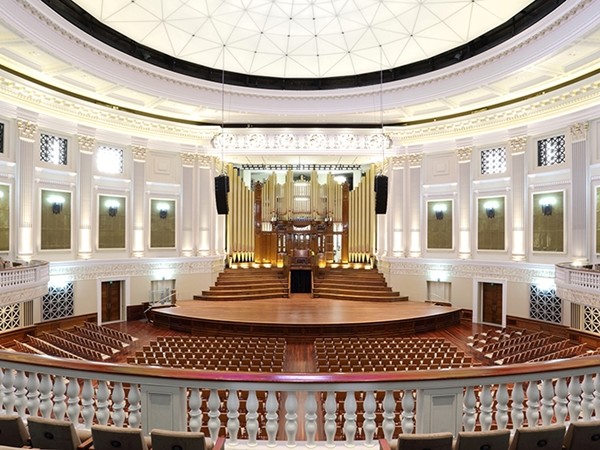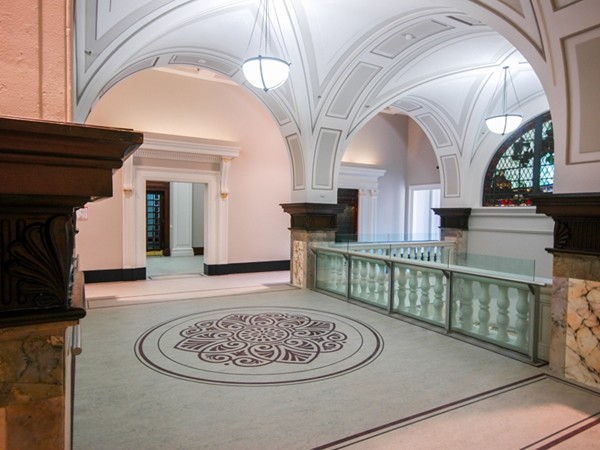The Brisbane City Hall project by Tanner Kibble Denton Architects (TKD) and GHD, or Tanner GHD – Architects in Association, is a comprehensive restoration program of an iconic building that has held, and continues to hold, a place in the heart of Brisbane’s history.
For decades, City Hall functioned as ‘the people’s place’, but over the years its age had begun to show. In 2009, council commissioned a $215 million revamp and upgrade of the building, stating its Functional Plan that all current functions of City Hall would be retained, with necessary improvements and changes to ensure it remains the focus of Brisbane’s civic, cultural and social events.
The works carried out by the architects are founded on a conservation mindset. Instead of starting from the ground up, they built on the underlying design and detailing, preserving the heritage spaces and built fabric while rectifying existing structural, fire, safety and access deficits.
New additions of contemporary relevance were therefore initiated within the overall constraints agreed for the project, with the restoration primarily seeking to re-equip the building for its purpose.
The main domed auditorium is a stellar example of the success of these aims. Exhibiting a seamless integration with the new structure, services and fittings, the auditorium’s functionality, acoustic performance, amenity and comfort have been improved without damaging or compromising the fabric and original design.

This integration can also be seen in other parts of the building, with energy efficient features included in the existing structure restored and reinstated. For instance, the courtyards and light wells that have been filled up with services over the years were reinvigorated. As far as possible within the budget, faux heritage overlays added in recent years were also removed, with original surfaces and details revealed and restored.
Another aspect the design team had to address was the functional amenity of the building, which had issues with code compliances. This included meeting disability compliant access and egress requirements, which were largely not catered for in the existing building.
“A key aim of the Brisbane City Hall Restoration Project was to improve the accessibility of the City Hall,” says TKD’s practice director, Megan Jones. “The architectural approach to the restoration of City Hall was to integrate requirements of code compliance and retention of heritage value.”
Working to a range of guiding architectural principles as well as an access report prepared by an access consultant, care was taken to ensure these access limitations were addressed without any detrimental heritage impact.
This included a range of initiatives which were carried out to provide for universal access at City Hall, a place that sought to be all-inclusive – from remediation work to stairs and balustrades for greater levels of safety, to increasing the seating capacity in viewing areas to accommodate for people with disabilities.

More accessible and disabled toilets have also been introduced in the heritage building, along with necessary equipment such as the ceiling mounted hoist system and Kerry Hydraulic Change Table from Evocare in the Adult Change toilets, and Barben stainless steel grab bars and Caroma’s CARE 800 Invisi II Suite in the accessible toilets.
Getting back to the basics, the team also recognised the importance of creating continuous paths of travel from key entry points in the Basement and Ground Floor to all areas, save for minor exemptions due to the configuration of the existing building. These pathways were made as level as possible, and where steps are necessary, alternative access via a ramp of lift would be available, with the appropriate handrails installed.

New lifts supplied by Otis Elevator Company were also installed as part of these continuous travel paths and deliberately located close to entrances. A wheelchair platform lift from the The LiftShop was fitted in to the front and back of the Main and Ithaca Auditoriums’ stages. According to Jones, these were selected because of their size, architectural profile, and minimal lift pit requirements.
Other ways in which the design team has tried to make access more equitable in City Hall include simplifying the way-finding process through communication systems and signs that incorporate the needs of those with physical and sensory disabilities, and creating lowered sections at reception counters to be within the reach of a person in a wheelchair.

Preventing slips and falls was also essential for what is expected to be a pedestrian-heavy building, with Forbo Flooring’s tactile ground surface indicators and stair nosing edge fitted on to the stairs.
With its spaces now readily and easily accessible to anyone who wants to visit, Brisbane City Hall is today able to showcase its architectural qualities and heritage whilst boasting of contemporary amenity and services that will secure for it a sustainable future.
Photography by Lachlan Rowe

